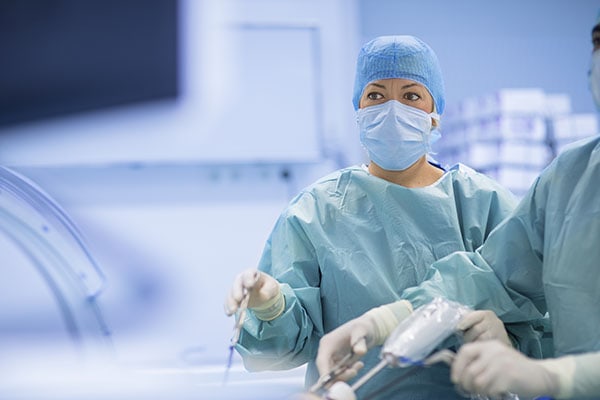Diagnostic and surgical laparoscopy
Diagnostic and operative laparoscopy is a minimally invasive surgical technique that allows the visualization of the abdominal cavity and the organs found in it to observe possible anomalies in the area and correct them in the best of cases. In the case of female fertility, laparoscopy will allow the doctor to diagnose complications in her reproductive organs.

What is the purpose of this technique?
Laparoscopy aims to diagnose and solve any problem detected during the procedure.
The main indications of this technique in gynecology are:
- The study of infertility
- The diagnosis of uterine malformations
- Chronic pelvic pain
- Tubal ligation and recanalization
- Endometriosis
- Ectopic pregnancy
- Management of ovarian and oophorectomy cysts
- Handling of tubal and salpingectomy abnormalities
- Ovarian drilling
- Myomectomy and hysterectomy
How is laparoscopy performed?
The procedure is usually performed in a hospital or outpatient surgical center using general anesthesia. The procedure is carried out as follows:
- The surgeon makes an incision at the navel.
- A needle is inserted into the incision. Then carbon dioxide is passed through the needle into the abdomen. The gas helps expand the area, giving the surgeon more room to work and assisting the physician in seeing the organs.
- A tube is placed through the incision in the abdomen. A video cam (laparoscopy camera) is then passed, and the abdominal cavity and pelvis are observed. Small incisions can be made in different locations, allowing for better visualization and manipulation of the affected organs. In the case of gynecology, these incisions are usually on the side of the abdomen, both on the right and left side.
- If a gynecological laparoscopy or fertility study is performed, a dye can be injected through the cervix to identify the Fallopian tubes and their permeability.
- After the study, the gas, the laparoscopy equipment, and the instruments are extracted to close the incisions.
How to prepare for a laparoscopy?
- Before the procedure, it is crucial not to consume food or liquid for at least 8 hours.
- It may be necessary to suspend any medication before the procedure, such as aspirin or anticoagulants, and other medicines on the day of surgery. The treating physician and anesthesiologist will inform the patient, which should be suspended.
- The doctor may make other recommendations, such as no smoking or drinking alcohol, following a special diet days before surgery, etc.
What are the risks of laparoscopy?
There is a risk of infection. For this reason, a prophylactic antibiotic (prevention) is used 30 minutes before the procedure, which will be administered intravenously and thus prevent complications.
There is a risk of organ injury. This may damage the bladder, intestines, or a blood vessel that may require an immediate change of procedure to surgery (laparotomy). It depends greatly on the surgeon’s experience, the history of previous surgeries, and the diagnosis for which the procedure is performed. However, this type of complication is not frequent and occurs in about 1 in every 500 to 5000 surgeries, depending on the complications.
Diagnostic laparoscopy may not be possible if the bowels are swollen or have fluid in the abdomen (ascites) or if the patient has had surgery in the past.
Contact us in our lines:
- Medellín: +57(4) 268 80 00
- Bogotá:+57(1) 746 98 69
- Cartagena: +57(5) 693 04 34
- Pereira: +57(6) 340 17 09
- Whatsapp: +57 316 3033866




